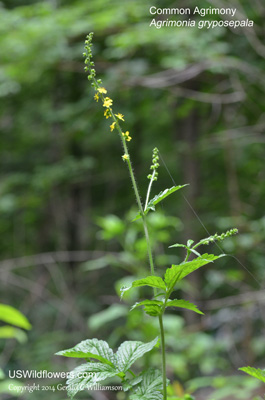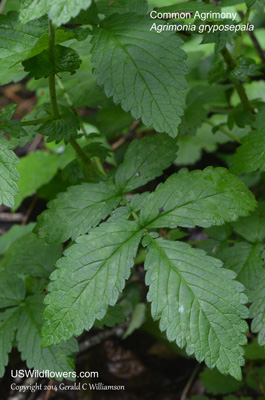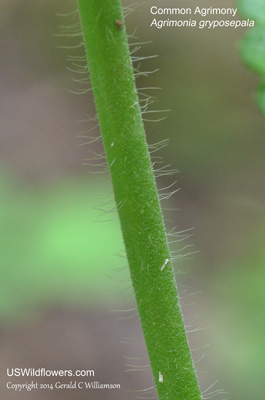Tall Hairy Agrimony, Common Agrimony, Hooked Agrimony, Tall Hairy Grooveburr - Agrimonia gryposepala
|
Agrimonia gryposepala - Tall Hairy Agrimony, Common Agrimony, Hooked Agrimony, Tall Hairy Grooveburr. Agrimonia is a relatively small genus, with about 10 to 15 species worldwide. More than half of those are found in the United States, with about 7 native species. Agrimonia gryposepala is the most widely distributed of those native North American species, being found from coast to coast except in a swath of states from Montana to Texas - those in the Rocky Mountains. It is also missing in Florida. It prefers moderately to very moist habitats. These photos were taken in Cosby Campground in the Great Smoky Mountains National Park, at an elevation of about 2500'.
The differences between some Agrimonia species are somewhat subtle. I think this is Agrimonia gryposepala because it has shiny, glandular hairs on the stem and inflorescence, I find no more than 5 major leaflets on the mid-cauline leaves (A. incisa and A. parviflora have 7 to 13), and the non-glandular (eglandular) hairs on the stem and inflorescence are erect (A. rostellata has ascending eglandular hairs in the inflorescence.) That leaves A. gryposepala and A. striata standing among the species found in the region where I found this specimen. Differences between these two species are noted in the descriptions of the photographs.
Found in:
AL, AR, AZ, CA, CT, DE, GA, IA, IL, IN, KS, KY, LA, MA, MD, ME, MI, MN, MO, MS, NC, ND, NE, NH, NJ, NM, NY, OH, OR, PA, RI, SC, SD, TN, VA, VT, WA, WI, WV, WY
Leave comments on Agrimonia gryposepala at this link. | 
Distribution of Agrimonia gryposepala in the United States and Canada:

Blue=Native; Grey=Introduced
Map from USDA Plants Database:
USDA, NRCS. 2017. The PLANTS Database (http://plants.usda.gov, 03 Apr 2025). National Plant Data Team, Greensboro, NC 27401-4901 USA.
Search Our Database: Enter any portion of the Scientific, Common Name, or both.
Do a general Google search of the entire site:
#ad
 Follow USWildflowers on Twitter
| | Site: Cosby Campground, GSMNP, Cocke County, TN Date: 2014-June-29 | Photographer: Gerald C. Williamson
Nikon D7000
Tamron SP 90MM f/2.8 AF Macro | | As is generally the case with Rosaceae, Agrimonia species have 5 petals and 5 sepals. Agrimonia has yellow petals, and fewer stamens that are found in many other genera in Rosaceae, although some Agrimonia species may have as many as 25 stamens. Agrimonia gryposepala has fewer than 15 or its stamens, which hold orange anthers. | | 
| | Site: Cosby Campground, GSMNP, Cocke County, TN Date: 2014-June-29 | Photographer: Gerald C Williamson
Nikon D7000 | | The several inflorescences are spikes of many yellow flowers along and atop a plant that may be 4 or more feet tall. | | Click on the photo for a larger image

| | Site: Cosby Campground, GSMNP, Cocke County, TN Date: 2014-June-29 | Photographer: Gerald C Williamson
Nikon D7000 | | The leaves of Agrimonia have large "major" leaflets with smaller "minor" leaflets between them. Agrimonia gryposepala will usually have more than one set of minor leaflets between the major leaflets, as shown here. I don't know about that attribute in Agrimonia striata, but the stipule shape also shown in this photo was key to my decision that this is Agrimonia gryposepala rather than Agrimonia striata - the stipule of A. striata is entire or toothed only in the lower part; that of A. gryposepala is toothed or lobed along its entire margin. | | Click on the photo for a larger image

| | Site: Cosby Campground, GSMNP, Cocke County, TN Date: 2014-June-29 | Photographer: Gerald C Williamson
Nikon D7000 | | The stem and lower inflorescence of Agrimonia gryposepala has erect, non-glandular hairs (those of A. rostellata are ascending rather than erect.) The whitish dots are glandular hairs. In the case of Agrimonia gryposepala the glandular hairs are both sessile and some are short-stalked; in those of Agrimonia striata the glandular hairs are only sessile. At the magnification of this photo I only see a few stalked, glandular hairs, but at higher magnification there are some that can be seen as stalked. | | Click on the photo for a larger image

|
References used for identification and information:
|
|
| |
| #ad
|
|






